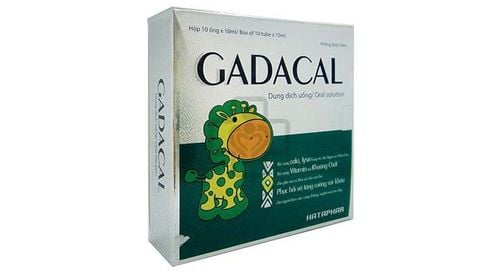This is an automatically translated article.
The article was professionally consulted by Specialist Doctor I Bui Thi Ha - Pediatrician - Neonatologist - Department of Pediatrics - Neonatology - Vinmec Ha Long International General Hospital.1. What is infant parenteral nutrition?
Premature, low birth weight babies do not have the opportunity to grow and develop fully in the mother's womb, so they have different physiological characteristics from full-term babies. The organ systems of premature infants, typically the digestive system, have not yet fully functioned as in full-term infants. Therefore, it is necessary to increase nutrition for premature babies to catch up with growth momentum. Measures include parenteral nutrition after birth and after switching to enteral nutrition.Intravenous nutrition is the introduction of nutrients through a vein into the bloodstream to nourish the body. Nutrients include: Protein, carbohydrates, lipids, water, mineral salts and trace elements. These nutrients can be given separately, mixed or infused at the same time.
Indications for parenteral nutrition for children have the following characteristics:
Children weighing < 1,500g; Children weighing ≥ 1500g but unable to eat enough through the gastrointestinal tract 130ml/kg/day after 3 days; Congenital malformations of the gastrointestinal tract (abdominal wall cleft, umbilical hernia, esophageal atrophy, small bowel atrophy, bowel incomplete rotation, meconium obstruction, diaphragmatic hernia,...); severe gastrointestinal disorders (severe gastrointestinal intolerance, severe vomiting, abdominal distention, prolonged diarrhea); gastrointestinal tract is severely damaged (heavy gastrointestinal bleeding, necrotizing enterocolitis); patients with medical conditions requiring immediate surgery, severe systemic diseases (unstable convulsions, breathing more than 80 breaths/minute, requiring vasopressors such as dopamine, dobutamine, adrenaline > 24 hours at a dose > 5mg/kg/min) . Currently, two methods of parenteral nutrition are being applied: central venous feeding and peripheral venous feeding. Peripheral vein feeding is easy to perform, has fewer complications, but requires many changes in the place of infusion, so it is usually only applied in the case of short-term feeding or only supportive feeding. Central venous feeding is usually indicated in cases where long-term feeding of more than 1 - 2 weeks is required, can provide more energy, but this technique is more complicated and has more complications.

2. Complications when using intravenous nutrition
Is parenteral feeding dangerous? Intravenous feeding is a complicated technique - a method of feeding that is not physiological, expensive, and carries a potential risk of many unpredictable complications such as:2.1 Complications related to nutrients
Hyperglycemia: Hyperglycemia is defined as a blood glucose level > 150 mg/dL. This complication is common in parenteral nutrition in preterm, low birth weight infants. Hyperglycemia causes increased blood osmolality, osmotic diuresis, dehydration, cerebral hemorrhage and increased mortality in preterm neonates. For management, the glucose rate can be reduced to 2 mg/kg/min every 4 hours. Insulin may be initiated at 0.01 IU/kg/hr if blood glucose > 180 mg/dL and urinary glucose 2 mg/dL + at a glucose rate of 6 mg/kg/min to lower blood glucose below 180 mg/dL . Measures to prevent hyperglycemia in preterm infants receiving total parenteral nutrition by early protid and early minimally digestible nutrition; Hypoglycemia: Hypoglycemia is defined as blood glucose levels below 40 mg/dl (in the first 24 hours postpartum) or less than 50 mg/dL (after 24 hours). This complication often occurs when total parenteral nutrition is discontinued in preterm, low birth weight infants. For treatment, slow intravenous injection of glucose 10% 2 - 3 ml/kg when the child has clinical symptoms of hypoglycemia (convulsions, limb tremor, decreased muscle tone, coma, lethargy, apnea, pulse rate). bradycardia, cyanosis, tachypnea, poor feeding, hypothermia) or when blood glucose falls below 25 mg/dL. In addition, the rate of glucose infusion can be increased to ≥ 6 mg/kg/min and can be increased to a maximum glucose oxidizing capacity in premature infants of 15 mg/kg/min. At the same time, it is recommended to check the child's blood sugar every 4 hours; Metabolic acidosis: May be related to causes such as infection, kidney failure, dehydration;
2.2 Complications related to nutrition catheters
Complications include infection, obstruction, extravasation, thrombosis, or pulmonary embolism.Besides, due to the absence of stimulating nutrients such as feeding through the gastrointestinal tract, intravenous nutrition easily leads to atrophy of intestinal villi, increasing the ability of bacteria to penetrate into intestinal parietal cells and easily Glutamine deficiency,...
Intravenous feeding for infants may cause some complications but is still indicated in special cases where gastrointestinal feeding cannot be achieved such as intestinal obstruction, continuous vomiting. , massive gastrointestinal bleeding, early stage acute pancreatitis,... However, it is not recommended to maintain long-term intravenous nutrition, but should gradually switch to a combination of gastrointestinal nutrition to improve function and integrity integrity of the intestinal mucosa.
Specialist Doctor I Bui Thi Ha has over 11 years of experience working in the field of Pediatrics - Neonatology; proficiently perform basic pediatric techniques and advanced, intensive and modern techniques such as mechanical ventilation, longline, blood exchange, invasive arterial blood pressure measurement, etc. Currently, the doctor is a Doctor. Pediatrics - Newborns, Vinmec Ha Long International General Hospital.
SEE ALSO:
Newborn nutrition for babies Nutrition guide for babies Detecting signs of abnormalities in babies at home
Please dial HOTLINE for more information or register for an appointment HERE. Download MyVinmec app to make appointments faster and to manage your bookings easily.














